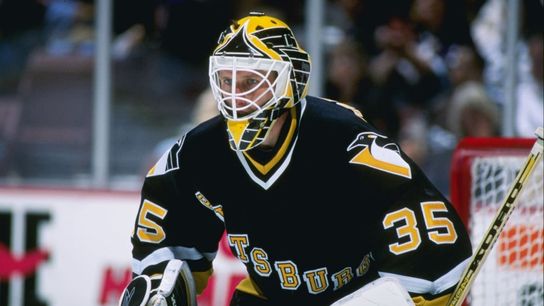From the first season of his career to the last, only five NHL goaltenders won more games than Tom Barrasso. Same goes for the postseason during that span, stretching from 1983-2003.
That, in addition to backstopping the Penguins to back-to-back Stanley Cups in 1991 and 1992, is the biggest reason why Barrasso was named to the Hockey Hall of Fame as part of the 2023 class on Wednesday. After all, the game is played to be won, and Barrasso did quite a bit of winning over an extended period.
After being selected fifth overall by the Sabres in the 1983 NHL Draft, Barrasso jumped straight to the NHL from high school hockey and excelled right away. Not only did he win the 1983-84 Calder Trophy as the league's top rookie, he also won the Vezina Trophy as the league's top goalie.
Barrasso then spent the next four-plus seasons with the Sabres before the Penguins traded for him in November 1988. Along with a third-round pick in 1990 that became Joe Dziedzic, the Penguins acquired Barrasso in exchange for Doug Bodger and Darrin Shannon.
The Penguins made out like bandits in that deal, as Barrasso went on to play 460 games with the team across parts of 12 seasons, posting a 226-153-53 record with an .895 save percentage, 3.25 goals-against average, 22 shutouts and a whopping 31 assists. Only Marc-Andre Fleury has more games played, wins and shutouts than Barrasso in franchise history.
Barrasso's peak with the Penguins, unquestionably, was his performance en route to those aforementioned Stanley Cups. During the postseason in 1991 and 1992, he went a combined 30-12 with a .913 save percentage, 2.72 goals-against average and two shutouts.
Those would be decent numbers in today's NHL, but to put them into context, consider that only three of the other 11 goalies to play at least 15 postseason games in that span had a save percentage above .900, and none of them had a higher mark than Barrasso's.
He shored up the goaltending position when it mattered most for the Penguins and became a vital component of reaching glory in consecutive years.
As for the regular season, only seven goalies won more games than Barrasso during his time with the Penguins. Again, winning matters more than anything else and that's why it's valued more than anything else, but it's hard to ignore that his save percentage and goals-against average did not stack up all that favorably against his peers.
There were 43 goalies to play at least 200 regular-season games from 1988-2000 (Barasso's years with Pittsburgh). He ranked 26th in save percentage (.895) and 36th in goals-against average (3.25). Dominik Hasek (.926, 2.26), Martin Brodeur (.913, 2.20) and Patrick Roy (.912, 2.55) blew him out of the water in this regard.
He was not great in the regular season. His individual numbers didn't really reflect a Hall of Fame-caliber goalie. But he still won games.
The Penguins eventually traded Barrasso to the Senators in March 2000, for Janne Laukkanen and Ron Tugnutt. Barrasso made only 48 starts over the next three-plus seasons before retiring at the conclusion of the 2002-03 season.
At the end of it all, Barrasso finished his career with an .892 save percentage and 3.24 goals-against average during regular-season action. Among 34 goalies to play 400 games from 1983-2003, he ranked 25th and 26th, respectively, in those categories.
Yeah, I know what you're thinking. Counterpoint: Just win, baby.
The Pidutti Point Share (PPS) system from Adjusted Hockey is a "comprehensive measure of Hockey Hall of Fame worthiness expressed in a single number. Using the methodology, each player in NHL history can be ranked and compared to a HHOF standard based on era and position."
The PPS system assigns a "score" to every player based on the sum of five factors:
1. Career value (output).
2. Pace value (efficiency).
3. Peak value (dominance over extended period of time).
4. Timeline (league strength).
5. Bonus value (postseason, international play, award shares).
The creator of the PPS system, Paul Pidutti, acknowledges that it does not capture or include certain variables like sportsmanship and character, social impact, pioneering influence and clutch play or key moments. It only includes a player's on-ice results.
From there, each player's assigned score puts them into a category deeming their Hall of Fame worthiness, or lack thereof:
• Inner Circle (far exceeds HOF standard)
• Qualified (exceeds HOF standard)
• Borderline: Above(slightly exceeds HOF standard)
• Borderline: Below (slightly below HOF standard)
• Hall of Very Good (below HOF standard)
• Everyone else (not a candidate)
To my surprise, considering his relatively unspectacular regular-season numbers, the PPS system assigned Barrasso a score of 311, which is the minimum score required to qualify for the "Borderline: Above" category.
Here's how he stacks up against goaltenders of the post-expansion era who are eligible for the Hall of Fame as of this year:

AdjustedHockey.com
No. 16 is higher than I would've pegged him, but I'm not in a position to argue with the time and thoughtful calculation that went into the PPS system.
If nothing else, I believe the PPS system shows that Barrasso being inducted to the Hall of Fame isn't outlandish. He has a legitimate case that could've gone one way or the other, and it fell in his favor because he did a whole lot of winning.


